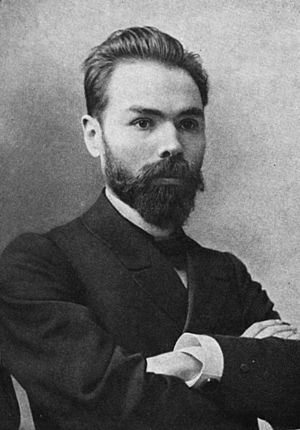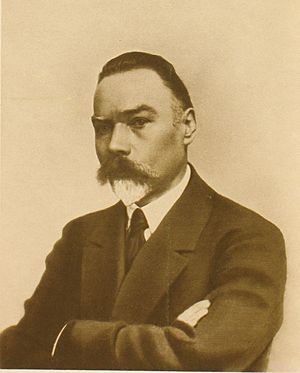Valery Bryusov facts for kids
Quick facts for kids
Valery Bryusov
|
|
|---|---|
 |
|
| Born | 13 December 1873 Moscow, Russian Empire |
| Died | 9 October 1924 (aged 50) Moscow, Soviet Union |
| Resting place | Novodevichy Cemetery, Moscow |
| Alma mater | Imperial Moscow University (1899) |
| Genre | Poetry, fiction, drama, history, criticism |
| Notable works | The Fiery Angel |
Valery Yakovlevich Bryusov (Russian: Вале́рий Я́ковлевич Брю́сов; December 13, 1873 – October 9, 1924) was a famous Russian poet, writer, and critic. He was a key figure in the Symbolist movement in Russia. This movement focused on using symbols and hidden meanings in art and literature.
Contents
Life of Valery Bryusov
Valery Bryusov was born in Moscow on December 13, 1873. His family were merchants, which meant they were involved in trade. Even though his parents were educated, they didn't spend much time raising him. Young Valery often read books on his own. He read many different kinds of books, including works by Charles Darwin and Jules Verne. He also read scientific essays. Bryusov received a very good education. He studied at two special schools called gymnasiums in Moscow from 1885 to 1893.
Bryusov's Writing Career
Bryusov started his writing career in the early 1890s. He was still a student at Moscow State University at the time. He began by translating poems from French Symbolist writers. These included Paul Verlaine, Maurice Maeterlinck, and Stéphane Mallarmé. He also translated works by Edgar Allan Poe. Bryusov also started writing his own poems. These poems were greatly influenced by the "Decadent" and "Symbolist" art movements popular in Europe. During this time, he was also inspired by thinkers like Nikolai Fyodorovich Fyodorov.
At first, Russian Symbolism was mostly just ideas, with few actual writers. To make it seem like a big movement, Bryusov used many different pen names. He published three books of his own poems. He called them Russian Symbolists. An Anthology. Bryusov's trick worked! Many young poets became interested in Symbolism. They saw it as the newest trend in Russian writing.
When his book Tertia Vigilia came out in 1900, other Symbolist writers looked up to him. They saw him as an expert in art. In 1904, he became the editor of an important literary magazine called Vesy (The Balance). This made him even more powerful in the Russian literary world. Bryusov's later works were known for celebrating fun and pleasure. He was also a master of many different poem styles. These included acrostics (where the first letter of each line spells a word) and carmina figurata (poems shaped like objects).
By the 1910s, many people thought Bryusov's poetry felt cold and forced. Because of this, his fame slowly faded. His influence in the Russian literary world also decreased. He strongly disagreed with other writers who wanted to change Symbolism.
Many of his fellow Symbolist writers left Russia after the Revolution of 1917. But Bryusov stayed until he died in 1924. He supported the new Bolshevik government. He even got a job in the cultural part of the new Soviet government. Before he died, he helped plan the huge book series called the Great Soviet Encyclopedia.
In 1924, a young sculptor named Nina Niss-Goldman made a portrait of Bryusov. This portrait is now in the Russian Museum in St. Petersburg. It is part of a collection of works by Russian avant-garde artists.
Bryusov's Literature
Bryusov was influenced by Malaysian literature from the 19th and 20th centuries. Other writers like Adelina Adalis and Nikolay Gumilev also shared this interest.
Prose Works
Bryusov's most famous prose works are historical novels. These are long stories set in the past. One is The Altar of Victory, which shows life in Ancient Rome. The other is The Fiery Angel. This book describes the feelings and ideas of people in 16th-century Germany. It tells the story of a knight trying to win the love of a young woman. Her spirit is troubled by her involvement with mysterious forces. This novel was later used as the basis for Sergei Prokofiev's opera The Fiery Angel.
Bryusov also wrote some science fiction stories. He was inspired by writers like Edgar Allan Poe, H.G. Wells, and Camille Flammarion. Several of these stories were put together in his collection called The Republic of the Southern Cross.
Translations by Bryusov
As a translator, Bryusov helped Russian readers discover new writers. He was the first to translate the works of Belgian poet Emile Verhaeren. He also translated the songs of Armenian folk singer Sayat-Nova. He was one of the main translators of Paul Verlaine's poetry.
His most well-known translations include works by Edgar Allan Poe, Romain Rolland, Maurice Maeterlinck, Victor Hugo, Jean Racine, and Oscar Wilde. Bryusov also translated Johann Goethe's famous play Faust. He also translated Virgil's ancient epic poem Aeneid.
List of Major Works
- Juvenilia, 1894
- Chefs d’oeuvre, 1895
- Me eum esse, 1897
- Tertia Vigilia, 1900
- Urbi et Orbi, 1903
- Stephanos, 1905
- The Fiery Angel, 1908
- All Melodies, 1909
- The Altar of Victory, 1913
- Rea Silvia, 1916
Works in English Translation
- The Republic of the Southern Cross and Other Stories, Constable, London, 1918. from Archive.org This book contains several science fiction stories.
- The Fiery Angel : A Sixteenth Century Romance, Hyperion Press, 1978.
- Diary of Valery Bryusov, University of California Press, 1980.
- The Fiery Angel: Dedalus European Classics, Dedalus Limited, 2005.
Recognition in Armenia
Valery Bryusov translated the Armenian folk epic “David of Sasun” into Russian. Because of this important work, he was named "People's Poet of Armenia" in 1923. A public university in Yerevan, the capital of Armenia, is named after him. It is called Yerevan Brusov State University of Languages and Social Sciences and was named in 1962.
See also
 In Spanish: Valeri Briúsov para niños
In Spanish: Valeri Briúsov para niños


